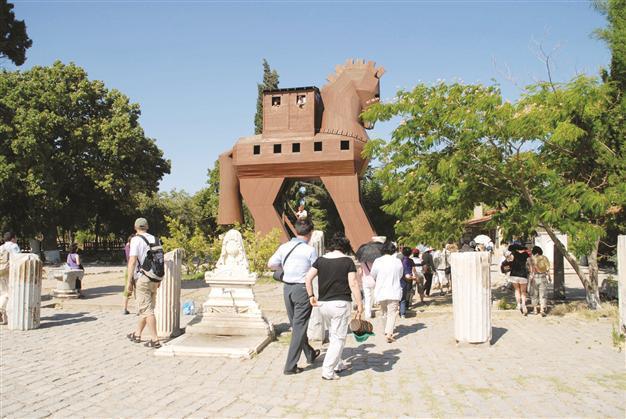Works halted in ancient Troy but museum still on the way
ÇANAKKALE - Anadolu Agency

For the first time this year, the ancient city of Troy was not excavated but works have bee continuing for the construction of the Troy Museum. DHA photo
Excavation works have stopped in the ancient city of Troy after German excavation teams left the area. The ancient city is located within the borders of Tevfikiye village in the northwestern province of Çanakkale and sheds light on a history of 5,000 years. Five different archaeologists have worked in the ancient city for 150 years and for the first time this year, the city was not excavated.
The first excavations started in the ancient city in 1863 by British archaeologist Frank Calvert. He revealed the Hisarlık Tepe during the works. German archaeologist Heinrich Schliemann found treasures in the ancient city but he smuggled the treasures in 1873. However, he continued excavations until he died in 1890.
Between 1932 and 1938, when U.S. archaeologist Carl William Blegen worked in the ancient city on behalf of the Cincinnati University, Troy became the most important place of modern archaeology.
German archaeologist Manfred Osman Korfmann, who worked there between 1988 and 2005 for the German Tübingen University, proved that Troy was an archaeological Anatolian city.
When Koffman died, German Professor Ernst Pernicak of the same university continued the excavations. But last year after finishing the works, Germans gave up working in Troy because of financial problems.
After Germans left the excavations, the Çanakkale Onsekiz Mart University (ÇOMÜ) Archaeology Department member Associate Professor Rüstem Aslan, who actively worked in the excavation area for 25 years and has been the co-chair for the last five years, applied to continue the excavations in the ancient city on behalf of the university.
Then the university applied to the Culture and Tourism Ministry last year. This summer, a Turkish university was expected to work in Troy for the first time in the city’s history but bureaucratic handicaps caused the excavations to stop completely. After many years of active working, the ancient city did not host excavation teams this year.
While ÇOMÜ was waiting for a reply from the ministry to continue excavations, the excavation season ended. But bureaucratic handicaps were still not overcome and the issue is now waiting for the decision of the Council of Ministers.
Museum construction continues In the meantime, the ancient city will have a museum next year. The museum, which will display works unearthed in Troy, will have a cost of 22 million Turkish Liras. The construction of the museum started on July 1 this year following a project competition. The works will be completed on Sept. 23, 2014 and the museum will include a 10,000-square-meter closed area, 3,000 square meters of which will be display halls. Troy will be depicted through modern museum techniques such as reconstructions, films and animations in the museum. The 24-piece artifacts, which are on display in 44 museums and collections in the world, will come home again. Also, the Troy artifacts, which were brought from the U.S. Penn Museum after 125 years, will be displayed in this museum.
Another 8,000-piece artifact, which was smuggled from the ancient city in 1873 and now at the Pushkin Museum in Moscow, might be returned to Turkey after the museum opening.
